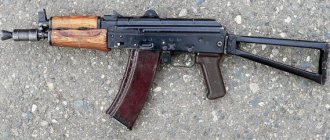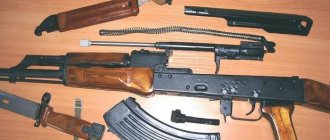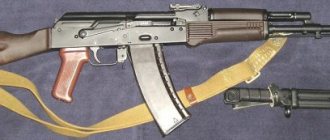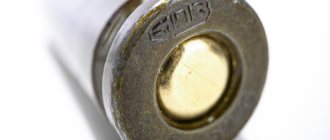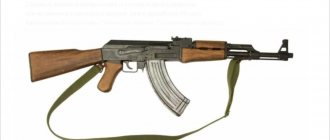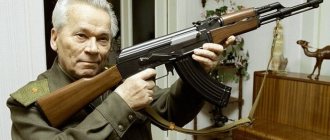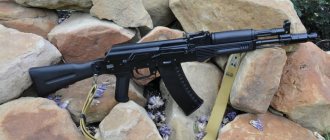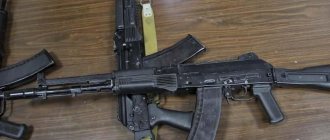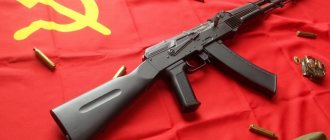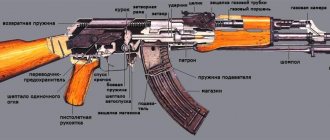TKB-415 assault rifle, which did not pass the competition
TKB-415 assault rifle by Tula gunsmith A.A. Bulkin was the main competitor of M.T. weapons. Kalashnikov during competitive testing of automatic samples chambered for the “intermediate” cartridge 7.62x39. Unfortunately, the designer failed to solve the problem of reliability and survivability of the parts of his weapon, which predetermined its fate.
Today, the most famous model of small arms in the world is the domestic Kalashnikov assault rifle, and it is known not only due to the record number of models produced in the USSR, Russia and many other countries, weapons of the AK family owe their fame primarily to the high level of technical excellence, the optimal combination of combat effectiveness, reliability, simplicity and ease of operation and maintenance. Of course, important credit for the creation of this wonderful model, or more precisely, a family of assault rifles with the AK brand, belongs to our famous gunsmith designer Mikhail Timofeevich Kalashnikov. But it was not only the personal talent of the then young, self-taught designer that made it possible to create a weapon that became the best in the world for many decades. The key to success was a competitive development system with serious multi-stage tests and participation in the competition by leading design bureaus and designers of our country. The new assault rifle was created in the intense competition of worthy rivals, and the main competitor of the Kalashnikov model was the assault rifle of the Tula designer Alexei Alekseevich Bulkin.
Weapon designer Bulkin Alexey Alekseevich
Work on creating a new type of individual automatic weapon for the newly developed “intermediate” ammunition began during the Great Patriotic War. In April 1944, F.V. samples arrived for field testing. Tokareva, V.A. Degtyareva, S.G. Simonova, S.A. Korovina, A.I. Sudaeva and V.F. Kuzmishcheva. In the summer of 1944, a second stage of testing took place, at which two new systems were presented - G.S. Shpagin and A.A. Bulkina.
The main design feature of the Bulkin sample was the first used in this type of weapon to lock the barrel by turning the bolt with three short lugs extending beyond the reciprocal ledges of the barrel coupling.
At the first stage, the best results were shown by the sample of Alexey Ivanovich Sudaev, which was put into mass production and, under the designation AS-44, was sent to military tests, which showed that, in general, meeting the requirements for fire power, the AS-44 was too heavy (5. 2 kg) and bulky, the reliability of the weapon was not adequately ensured.
Having received the results of military tests, in 1945 the GAU decided to organize a competition for the development of a new machine gun. According to tactical and technical requirements (TTT) No. 3131, “the machine gun must be an individual weapon intended for arming machine gunners in rifle units, in special teams of all branches of the military, instead of the PP-41 (PPSh) and PP-43 (PPS) in service. ... The machine gun is intended primarily for hitting living targets at firing ranges of up to 500 m, the target firing range is 800 m.” The weight of the machine should be no more than 4.5 kg, length no more than 950 mm.
7.62-mm experimental Sudaev AS-44 assault rifle
In accordance with these TTTs, N.V. developed their samples. Rukavishnikov, A.A. Bulkin, A.A. Dementyev, G.A. Korobov and M.T. Kalashnikov. Sample of designer TsKB-14 A.A. Bulkin AB-46 was distinguished by a number of technical solutions that were subsequently used in the model adopted for service. The AB-46 had gas-operated automatics and used the same successful locking scheme as the previous automatic. The coupling of the bolt with the barrel coupling, which absorbed the load when fired, made it possible to manufacture the receiver by stamping from sheet metal. The rod with the gas piston was permanently connected to the bolt frame, representing a single part. The charging handle is located on the right and is stationary when firing, the forend is removable, the receiver cover completely covers the moving parts and is fixed by the heel of the return spring guide.
Competitive tests were carried out in the summer and autumn of 1947. None of the presented samples fully met the requirements. After analyzing the test results, the commission recommended the machines that showed the best results for further refinement. These were samples of Bulkin, Dementyev and Kalashnikov.
On top is a 7.62-mm experimental Bulkin AB-46 assault rifle, on the bottom is a 7.62-mm experimental Bulkin TKB-415 assault rifle
Mikhail Timofeevich was well aware that his AK-46 model was not clearly the best at that time and was among the top three, mainly due to the potential for improvement that the commission members saw in it - “there were enough weaknesses in the model” (M.T. Kalashnikov “Notes of a gunsmith designer”). And in order to translate the potential inherent in the prototype into a real product, a very serious design redesign was required. Head of the testing department V.F. Lyuty, Sergeant Kalashnikov’s immediate superior, writes: “I came to the conclusion that the design should be redone almost anew...”.
From top to bottom: 7.62 mm experimental Bulkin TKB-415 assault rifle, 7.62 mm experimental Kalashnikov AK-46 assault rifle, 7.62 mm experimental Kalashnikov AK-47 assault rifle
Modified versions of M.T. assault rifles Kalashnikov (AK-47), A.A. Bulkina (TKB-415) and A.A. Dementyev (KB-P-410) were submitted for testing in December 1947. All competition participants provided machine guns with wooden and metal folding stocks. The samples of Dementyev and Bulkin, as provided for by the terms of the competition, were modified versions of previously tested machine guns. The AK-47 was actually a completely new model. M.T. Kalashnikov writes in his memoirs: “At this time, Sasha Zaitsev and I, secretly from the management, had a daring plan: to masquerade as modifications, to make a major re-arrangement of the entire machine gun. We took, of course, a certain risk: the terms of the competition did not provide for re-arrangement. But it significantly simplified the design of the weapon and increased its reliability in operation under the most difficult conditions. So the game was worth the candle. We were worried about one thing: will we be able to meet the deadline allotted for finalizing the sample” (M.T. Kalashnikov “Notes of a gunsmith designer”). Along with the rearrangement, the AK-47, unlike the AK-46, is similar to the A.A. Bulkin, received a bolt frame permanently connected to the gas piston, a removable forend, the charging handle moved to the right side, the receiver cover completely covers the moving parts and is fixed by the heel of the return spring guide, the design of the trigger mechanism and the fire selector has changed.
Incomplete disassembly of the Bulkin TKB-415 assault rifle
As test engineer A.A. notes in his book “Domestic Automata”. Malimon, who worked during the testing period at the test site: “...between these two systems (AK-47 and TKB-415) in individual components, great structural similarities have been created.” It should be noted that at that time, “Borrowing what had already been created, which had practical prospects for the development of new systems... was recommended by the test site and the State Agrarian University. Subsequently, this began to be reflected in the directives of the Main Directorate of the Ministry of Defense and the Industry Ministry.” This approach was established during the war and was completely justified; the shortest possible time was given to create the samples necessary for the army, and the lack of modern weapons was paid for with the most expensive thing - the lives of soldiers. At the end of the 1940s, the threat of the Cold War turning into a real military conflict with former allies in the anti-Hitler coalition remained very real and the need for new automatic individual weapons was extremely high.
The window for passing the cocking handle of the TKB-415 assault rifle is closed with a cover that slides down and back, preventing dirt from entering the automatic box
In January 1948, the tests were completed. Only AA machine Bulkin, when firing in short bursts from a rest under the forend, showed accuracy that satisfied the TTT, and also together with an A.A. Dementyev, as in previous tests, consistently showed slightly better results in terms of accuracy of automatic fire in individual shootings. Due to the simplicity of the device, the ease of disassembly and assembly, and maintenance during firing, the A.A. Bulkin was equivalent to the M.T. Kalashnikov. However, in the TKB-415 A.A. Bulkin was never able to solve the problem of reliability and survivability of weapon parts, which predetermined his competitive fate. The results of the tests were summed up in the test site report dated January 10, 1948, which stated that “the 7.62-mm Kalashnikov assault rifle chambered for the 1943 model cartridge, in terms of failure-free operation, survivability of parts and operational characteristics, basically satisfied the GAU TTT and can be recommended for production of a series and subsequent military tests. The 7.62-mm assault rifles designed by Bulkin and Dementyev do not satisfy the main technical specifications of the GAU and did not withstand field tests.”
On top is a 7.62 mm experimental Kalashnikov AK-46 assault rifle, on the bottom is a 7.62 mm experimental Kalashnikov AK-47 assault rifle
Partial disassembly clearly demonstrates how radically redesigned the AK-47 assault rifle (bottom) is compared to the AK-46 (top)
In 1949, the 7.62-mm Kalashnikov AK assault rifle (index 56-A-212) was adopted by the Soviet Army, which was destined to become the best example of such weapons in the world. The AB-46 and TKB-415 assault rifles did not go into mass production, but with these developments A.A. Bulkin contributed to the creation of the world's most famous machine gun.
Main performance characteristics of the Bulkin TKB-415 assault rifle (version with a non-folding stock):
| Chuck type | 7.62 mm mod. 1943 |
| Automation type | gas outlet |
| Shooting mode | single, automatic |
| Rate of fire, rds/min | 540–690 |
| Store capacity, cartridge | 30 |
| Sighting range, m | up to 800 |
| Weight with magazine without cartridges, kg | 4,3 |
| Barrel length, mm | 400 |
| Weapon length, mm | 878 |
Yuri Amelin, Boris Markov “Weapon” No. 04-2009
The main competitor of the AK-47 in competitive testing is the Bulkin AB-46 assault rifle
A prototype of the AB-46 automatic weapon with production index TKB-415, developed by Tula designer A. Bulkin, appeared in 1945. In the same year, he took part in the competition of the State Autonomous Institution of the Armed Forces of the Soviet Union, together with other copies of the new machine gun from various design bureaus. Three years later, the TKB-145 assault rifle is inferior in the ongoing competition to the prototype KB-P-580, which in the future will become known as the AK-47.
The Main Artillery Directorate announced a competition for the creation of automatic weapons - ammunition at the end of 1943. This event was greatly facilitated by the presentation to the technical council of the People's Commissariat of Armaments in mid-1943 of the German captured MKb-42 machine gun with its ammunition.
The domestic analogue of the German cartridge of 7.62 mm caliber with a sleeve length of 41 mm, called intermediate, was created by Soviet designers Semin and Elizarov in an incredibly short time - by the end of the year the cartridge was ready for testing. Later the sleeve was shortened by 2 mm.
All competitors developed machine guns for new domestic ammunition. In the first competition, the victory was awarded to the designer A. Sudaev - his development, the automatic carbine AS-44, weighing 5.35 kilograms, was mass-produced at the Tula plant. At this time, the AS-44 has successfully proven itself in tests in 4 military districts and was used by the occupying forces of the Soviet Union in occupied Germany. The designer was recommended to reduce the weight characteristics of the AS-44. In the summer of 1945, the GAU announced the start of the second competition. A. Sudaev presented his improved AS-44 or OAS. At this competition, the AB-46 designed by Bulkin appeared for the first time among the competitors. This time Sudaev’s lightweight assault rifle was unable to demonstrate its previous characteristics; the assault rifle designed by Bulkin passed the competition with some comments and, after modifications, was able to take part in the upcoming tests. The sudden death of Sudaev put an end to the future of his brainchild AS-44, which was the clear leader among the competitors. The remaining competitors, with new efforts, begin to fight for the primacy of their type of automatic weapon. The GAU takes into account the changed situation and presents tactical and technical requirements to the competition participants, reviewing the preliminary design of each machine gun before demonstrating the prototype. After reviewing the sketches for approval for testing, the State Agrarian University selects only 5 projects. An assault rifle developed by Kalashnikov first appeared here. A sample of an automatic carbine designed by Bulkin was the leader for almost 2.5 years of testing. At the beginning of 1948, all tests were completely completed. In terms of accuracy of fire in short bursts, the AB-46 was the only machine gun that met the requirements of the GAU. In terms of other shooting characteristics, it also performed well. In terms of maintenance, simplicity and ease of assembly and disassembly, it was not inferior to the Kalashnikov automatic carbine. But Bulkin failed to solve the problems of survivability and reliability of his machine gun, which, in the end, negated all its advantages. The results of the latest tests were recorded in a report on January 10, 1948, “a sample of an automatic weapon designed by Kalashnikov for ammunition of the 1943 model met the requirements of the GAU in many respects and is recommended for mass production with military field tests. The AB-46 assault rifle designed by Bulkin did not meet the GAU requirements and did not pass the main tests.” The KB-P-580, also known as the AK-47, passed the 10-day final tests. It is possible that it was thanks to the constant support of the leadership, as well as the introduction of AB-46 design elements into the AK-47, that the competition for the GAU automatic ammunition was won. Therefore, in 1949, a 7.62 mm assault rifle designed by Kalashnikov under the designation 56-A-212 was adopted. The automatic weapon designed by Bulkin was not mass produced, but it made its unique contribution to the now most famous AK-47.
Experimental assault rifle AB-46. USSR
I found an article on the Courage2004 website that I think will be of interest to my colleagues.
The first prototype of the AB-46 assault rifle (production index TKB-415) designed by the Tula TsKB-14 designer A. Bulkin entered competitive testing at the Small Arms Research Site of the Main Artillery Directorate of the USSR Armed Forces in 1945 with samples of other design bureaus. In January 1948, it lost primacy to the KB-P-580 assault rifle, the future AK-47 developed by the KB team at Kovrov Arms Plant No. 2. This description demonstrates one of the early samples of an assault rifle, distinguished, in particular, by a long (510 mm) barrel.
The competition for the creation of a Soviet complex consisting of a cartridge-automatic machine was announced by the GAU in early November 1943 after at the technical council of the People's Commissariat of Armaments on July 15, 1943, military and civilian specialists were shown captured German weapons - the MKb.42 automatic carbine and cartridges for it .
The domestic 7.62×41 mm cartridge, called “intermediate”, with a sleeve 41 mm long was developed in record time (by the end of 1943) by the leading engineer of the Klimov Research Institute-44 P. Ryazanov under the leadership of the chief designer of the institute, ballistics scientist N Elizarova. Among the competitors for the development of a new type of weapon were famous designers: V. Degtyarev, F. Tokarev, G. Shpagin, S. Korovin, A. Sudaev and others. The unconditional victory in this competition was won by Sudaev. In the summer of 1945, his AS-44 assault rifle, which weighed 5.35 kg with a magazine without cartridges and was mass-produced by the Tula arms factory, was successfully tested in four military districts and in the Group of Soviet Occupation Forces in Germany. As a result of the tests, it was recommended to slightly reduce the weight of the machine.
In mid-1945, a second competition was announced, in which, among others, the Sudaev OAS assault rifle, lightened to 4.77 kg, took part and the A. Bulkin assault rifle was presented for the first time. At this competition, the lightweight OAS assault rifle did not live up to the hopes placed on it - the spread of its hits due to the increased recoil force turned out to be significantly greater than that of the AS-44, which required modification of the assault rifle. The Bulkinsky machine with comments was recommended for subsequent tests. However, unexpectedly, 35-year-old Sudaev fell ill and died, and his machine gun, the clear leader of the competition, was removed from testing. Among the remaining contestants, the struggle for championship resumed.
Considering the complexity of the issue, the GAU Small Arms Directorate decided to announce a new competition for the updated tactical and technical requirements of the GAU with a preliminary consideration of the preliminary designs of the proposed assault rifles. Kalashnikov's proposal appeared for the first time at this competition.
